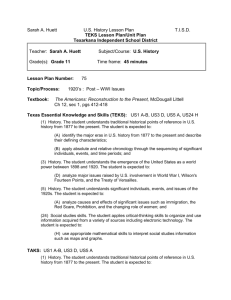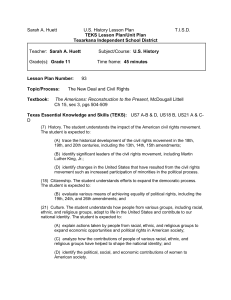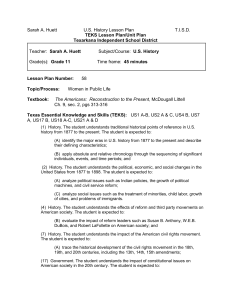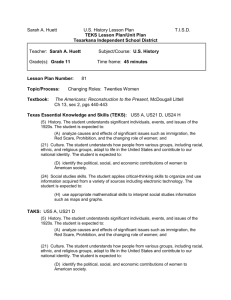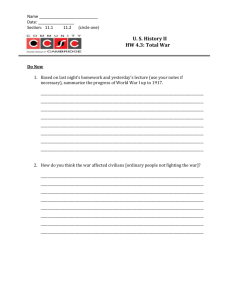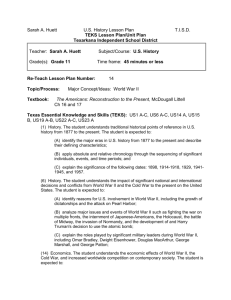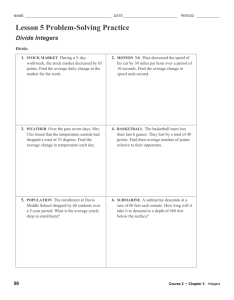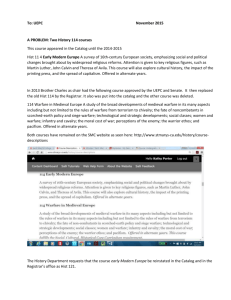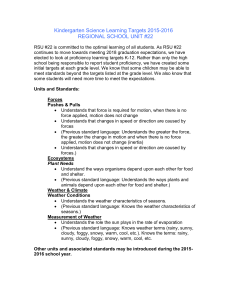Lesson Plan 70 - Texarkana Independent School District
advertisement
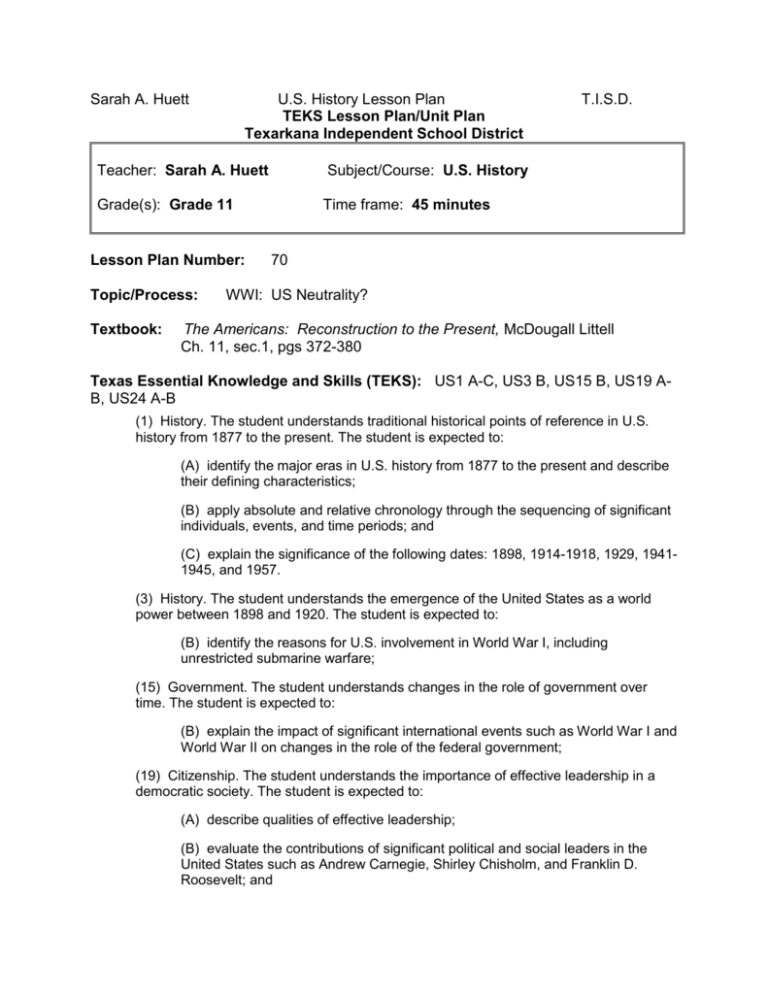
Sarah A. Huett U.S. History Lesson Plan TEKS Lesson Plan/Unit Plan Texarkana Independent School District Teacher: Sarah A. Huett Subject/Course: U.S. History Grade(s): Grade 11 Time frame: 45 minutes Lesson Plan Number: Topic/Process: Textbook: T.I.S.D. 70 WWI: US Neutrality? The Americans: Reconstruction to the Present, McDougall Littell Ch. 11, sec.1, pgs 372-380 Texas Essential Knowledge and Skills (TEKS): US1 A-C, US3 B, US15 B, US19 AB, US24 A-B (1) History. The student understands traditional historical points of reference in U.S. history from 1877 to the present. The student is expected to: (A) identify the major eras in U.S. history from 1877 to the present and describe their defining characteristics; (B) apply absolute and relative chronology through the sequencing of significant individuals, events, and time periods; and (C) explain the significance of the following dates: 1898, 1914-1918, 1929, 19411945, and 1957. (3) History. The student understands the emergence of the United States as a world power between 1898 and 1920. The student is expected to: (B) identify the reasons for U.S. involvement in World War I, including unrestricted submarine warfare; (15) Government. The student understands changes in the role of government over time. The student is expected to: (B) explain the impact of significant international events such as World War I and World War II on changes in the role of the federal government; (19) Citizenship. The student understands the importance of effective leadership in a democratic society. The student is expected to: (A) describe qualities of effective leadership; (B) evaluate the contributions of significant political and social leaders in the United States such as Andrew Carnegie, Shirley Chisholm, and Franklin D. Roosevelt; and Sarah A. Huett U.S. History Lesson Plan T.I.S.D. (24) Social studies skills. The student applies critical-thinking skills to organize and use information acquired from a variety of sources including electronic technology. The student is expected to: (A) locate and use primary and secondary sources such as computer software, databases, media and news services, biographies, interviews, and artifacts to acquire information about the United States; (B) analyze information by sequencing, categorizing, identifying cause-andeffect relationships, comparing, contrasting, finding the main idea, summarizing, making generalizations and predictions, and drawing inferences and conclusions; TAKS: US1 A-C, US3 B, US24 A-B (1) History. The student understands traditional historical points of reference in U.S. history from 1877 to the present. The student is expected to: (A) identify the major eras in U.S. history from 1877 to the present and describe their defining characteristics; (B) apply absolute and relative chronology through the sequencing of significant individuals, events, and time periods; and (C) explain the significance of the following dates: 1898, 1914-1918, 1929, 19411945, and 1957. (3) History. The student understands the emergence of the United States as a world power between 1898 and 1920. The student is expected to: (B) identify the reasons for U.S. involvement in World War I, including unrestricted submarine warfare; (24) Social studies skills. The student applies critical-thinking skills to organize and use information acquired from a variety of sources including electronic technology. The student is expected to: (A) locate and use primary and secondary sources such as computer software, databases, media and news services, biographies, interviews, and artifacts to acquire information about the United States; (B) analyze information by sequencing, categorizing, identifying cause-andeffect relationships, comparing, contrasting, finding the main idea, summarizing, making generalizations and predictions, and drawing inferences and conclusions; Concepts Enduring Understandings/Generalizations/Principles The student will understand that War/Conflict Cultural diversity can lead to conflict/war. Differences among people can create conflict/war. Social, economic and political oppression often leads to conflict/war. Similarities and differences among people and nations influence relationships. Relationships Sarah A. Huett U.S. History Lesson Plan Sequence of Activities (Instructional Strategies): T.I.S.D. 1. Focus: Have students read “I Didn’t Raise My Boy to be a Soldier” and “I Have a Rendezvous with Death”. What messages do the poems convey? How do they differ? 2. Lecture/Class Discussion: Discuss with students the basis for the divided loyalties in the U.S. Next discuss the ways in which the war affected the United States: blockade, u-boats, unrestricted submarine warfare and the Lusitania. Finally, discuss the Zimmermann Notes and Wilson’s declaration of war. 3. Activity: Have students examine the coded and decoded Zimmermann Note. Next, have students decode a message that is written in a code similar to that of the Zimmermann Note. Activities such as this can be found on the Internet. Questions to Consider in Lesson: 1) Was the U.S. ever really “neutral”? 2) Why did the U.S. began to favor Britain and France? 3) How did Germany’s unrestricted submarine warfare affect public opinion in America? Assessment of Activities: Classroom Observation Classroom Discussion Prerequisite Skills: 1. Literature Analysis Key Vocabulary: Neutrality, blockade, u-boat, unrestricted submarine warfare, Lusitania, Zimmermann Note Sarah A. Huett U.S. History Lesson Plan T.I.S.D. Materials/Resources Needed: Overheads, projector, computer, LCD projector, copies of poems, copies of Zimmermann Note, copies of Decoding Activity Modifications: Allow students to have extended time to complete activities. Follow all modifications on student’s IEP. Differentiated Instruction: Have students create a political cartoon or bumper sticker either for or against U.S. involvement in WW1. Have students write a paragraph explaining their creation. Teacher Notes: The poems “I Didn’t Raise My Boy to be a Soldier” and “I Have a Rendezvous with Death” can be found in the following book : The American Reader: Words that Moved a Nation, edited by Diane Ravitch, 1990, HarperCollins Publications. Sample Test Questions: 1. The policy that kept the United States out of the war for three years was called A. nationalism B. the alliance system C. neutrality D. the convoy system 2. Of the following, the most compelling reason for the United States to enter the war was A. moral obligation to halt the refugee crisis in Belgium B. concern over the repayment of Allied debts to American banks C. a desire to become more involved in the affairs of Europe D. the outrage of American citizens over German submarine warfare Project developed and delivered through a Collaborative Research Grant between Texarkana Independent School District and TAMU-T Regents’ Initiative.
